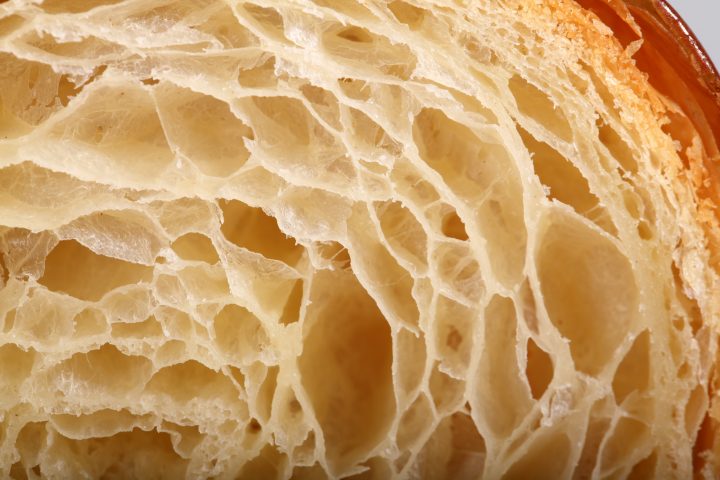
Baking croissants is always a work in progress, hopefully these answers are useful if you are up for the croissant baking challenge…
A lot of (first time) croissant bakers ask pretty much the same questions when tackling this challenging pastry. We composed a list of the top questions with our answers. Pretty sure your question will be answered here. Now lets get to the point of your very valid questions!
GENERAL RECIPE QUESTIONS
Why is your version a three day recipe?
The three day croissant recipe schedule is done for the right planning of the whole process so you can make your croissants on the third day in the morning, but of course you can take less time if this fits your timing better. Take a look at our one day version of this recipe too.
I am a first time croissant baker. What is your best advice?
Choose a cold day with a room temperature below 20 ºC / 68 ºF for your first attempt. This way you will have more time for the whole process and less chance of butter being absorbed by the dough. The key is to keep the butter solid between the layers of dough, this is what gives the croissant its flakiness.
My first attempt croissants look nothing like the ones in your pictures! What did I do wrong?
Do not expect to get perfect croissants the very first time you try to make croissants, most people need to make them 3 to 4 times to get the general feeling for the process. There is no substitute for practice and experience. There is no way to hide little mistakes in your technique when making croissants, so work very precise and follow the instructions to the letter. One small mistake is no problem but several small mistakes add up!
My croissants have a bread-like crumb and no layers. What did I do wrong?
Several factors can be the cause of this. Most likely it is an accumulation of things going sideways. It starts with pressing too hard on the dough to try and lengthen it while it is already fighting back. Keeping at this for a while means, next to the pressing on the dough, you are taking too long and the butter starts to get warm and is absorbed by the dough. So in this case, while still learning and getting better and faster, until you do make sure you build in extra fridge time to cool the dough and then continue. Handle the dough with care, gently elongate without pressing too much or putting your weight into it.
Can I turn your croissant recipe into a sourdough version?
We would recommend finding a recipe that is already a worked out version for sourdough croissants. We are not really a fan of the sour taste in pastry and for that reason we do not have enough experience to guide you to a good enough result.
Can you provide the measurements as ml, tsp, cups, instead of grams for all the ingredients?
We very much recommend weighing your ingredients. Professional bakers use scales (also in the US) and in Europe home bakers do too. A scale will give you the exact same weight every time. Which is absolutely needed if you consistently want to make good bread and especially good pastry. You can get a scale for the same price as a few sacks of good flour and less than a lot of baking tools you already own, so if possible, go and get one!
What are the measurements if I only want to make half of your recipe?
If you halve the recipe, the dough square should be 18.4 x 18.4 cm and the butter slab 12 x 12 cm.
Put the butter slab on top of the dough square and wrap the butter.
Roll the dough into a 20 cm x 30 cm rectangle.
Fold letter style to a 20 cm x 10 cm rectangle.
Turn dough 90 degrees.
Roll from the short 10cm side to a 20cm x 30cm rectangle (the short 10cm side will get 30cm).
Turn dough 90 degrees.
Roll from the short 10cm side to a 20cm x 30cm rectangle (the short 10cm side will get 30cm).
Turn dough 90 degrees.
Roll from the short 10cm side to a 20cm a 55cm rectangle (the short 10cm side will get 55cm).
The size of the final dough, right before cutting, should be 20 x 55 cm.
Although it is possible to use halve the dough we advise to make the full recipe as described in the recipe as the geometry of the shapes are much easier to work with.
You can always use halve and freeze the other halve.
I want to bake croissants, but live in a tropical location. Can I still make them?
We have gotten tips from people who have successfully baked croissants in the tropics. The top tips:
Cool ingredients and even utensils in the fridge before use, and use the fridge a lot to cool your dough and cool for longer if needed.
Roll the dough at night, when it is cooler. Check the weather reports and choose the coolest period possible.
BUTTER
My butter breaks into pieces. What should I do?
We use organic butter with a high fat content and low water content (about 82% fat). A higher water content tends to make butter hard, which promotes tearing and breaking and ruins the layers. Your butter needs to be pliable and at the same time not too soft at the moment of usage.
Help, butter leaks out when baking!
Your croissants were probably under-proofed. Just let them proof a bit longer so they get wobbly and increase visually in size. When under-proofed the butter tends to leak out from in between the layers and you end up with a butter puddle.
There’s so much butter in these croissants! Can I use less?
We would suggest making the recipe with the amount of butter indicated, enjoy the croissants and just try to eat less instead of a less than buttery croissant.
Next day eat soup and a salad.
FLOUR
Can I use another type of flour than the French type 55 you use?
For a good croissant you need the right type of flour. We have tried at least 5 different types and brands before we found a winner. If you cannot get the type 55 French flour try to find a flour with around 11% protein (this can be an all purpose / plain flour) and make sure it is a good quality flour. Try different brands if needed or use a combination of flours. Using 100% bread flour can make your result ‘heavy’ so try a combination with all purpose for instance.
DOUGH
My dough was too moist and sticky to handle. What should I change?
First of all it seems your flour absorbs less moisture than the type 55 flour we are using and you need to make adjustments by using a little less moisture next time.
My dough resists and shrinks back when I try to roll it out. What can I do?
At any stage when the rolling of the dough gets harder you can cover the dough and let the gluten relax for 10 to 20 minutes in the fridge before continuing.
If you keep on pressing the dough, trying to roll it while it resists, you will damage the layers!
SHAPING, PROOFING & YEAST
Can I use fresh yeast instead of instant yeast?
Yes you can. Use three times the amount given (so for our recipe 33 grams of fresh yeast).
Can I use active dry yeast instead of instant yeast?
Yes you can. Use 1.2 times the amount given (so for our recipe 13.2 grams active dry yeast).
At what stage should I add filling to my croissants?
You add filling just before the shaping / rolling up stage. Be aware that any filling will affect the layers and you will need less filling than you probably think. With chocolate for instance you will need no more than 5 to 7 grams per croissant. Professional bakers use stick chocolate for this, but you can use your own good quality (dark) chocolate. Fillings like jams are often added (injected) after baking.
I want to shape my croissants like a crescent. Why are your croissant not crescent shaped?
According to Raymond Calvel croissants laminated with margarine are formed into the crescent shape, while croissants laminated with butter are left in the straight form. We say, use whichever shape you like best, but do use real (organic) butter!
My croissants do not puff up like yours. What should I do?
First check the ‘sell by’ date on your packet of yeast and see if it is still OK to use it. Also make sure the temperature of your dough and proofing environment are correct.
Ideally you should proof the croissants draft-free at a temperature of 24ºC to 26.5ºC / 76ºF to 79ºF
BAKING
Why are my croissants under/over cooked?
Check the true temperature of your oven and see if any adjustments need to be made there. See our tips on the subject: Bread baking tips: Making the most of your oven.
Why are there pools of butter at the bottom of my baking pan when baking the croissants?
This could be a result of under-proofing, so make sure you proof at the right temperature and take the time to proof to perfection and get that nice wobble in your dough. It could also be you were not as meticulous as needed during the lamination process, so stick to the measurements, make sure they are as exact as possible, the edges are straight and follow our laminating instructions carefully.
Help my croissants split open during baking! What did you do wrong?
We suspect your croissants lack real layering and therefor are more bread-like with a lot of butter incorporated. Because they have this substance and are under-proofed and lack layering, you get an oven-spring during baking and the bread splits at its weakest points. With correct layering you get air pockets which will be able to expand and not rupture.
So try to work on your layering by keeping the laminated dough cool, work fast and do not press on the dough when rolling it but gently elongate it.
I want to freeze my croissants and bake at a later stage. What is the best way to do this?
Check out our tips for retarding and freezing with the one day version of our croissant recipe.
You can always find a way to adjust the recipe to fit your schedule.
What do I do to keep baked croissants fresh?
We would advice to put the croissants you do not eat on baking day in the freezer, after they have cooled. For extra flakiness and ‘almost as good as freshly baked’ you can put them into an oven for about 8 minutes at 175°C / 345°F, straight from the freezer.










Michelle says
After the last lamination and fold when the dough is placed in the fridge overnight, is it normal for the dough to have risen? Or has my dough got too warm during the last lamination? I found it tricky to degas the dough in the morning when it came time to role, shape and cut.
Weekend Bakers says
Hello Michelle,
Yes, no worries, this is normal. First just very gently roll on the dough to degas it and then continue with the process of rolling out the dough into a long strip.
Best of luck with the croissant making and enjoy!
Michelle says
Great, thank you!! 🥐
Jan says
I am confused about this process.
How critical is it after the third roll and rested overnight in the refrigerator, the LENGTH of time you can do before making the final roll of cutting and shaping?
Can you leave the dough in the refrigerator another night or would it be better to cut and shape than freeze ?
Or can you roll, cut and shape then leave this final product in the fridge before proofing?
Weekend Bakers says
Hello Jan,
At the end of the recipe of our one day version of the croissant recipe you can find a whole section on retarding and freezing your croissants:
www.weekendbakery.com/posts…nt-recipe/
Because this is a yeast based dough and the yeast, although slower, still stays active and grows in the fridge, there is an end to the length of time you can store dough in the fridge. Another night will not be a good idea. So the freezer will be a good option if you need extra time.
See the options you have with the retarding and freezing tips we give with the one day croissant recipe and hopefully you will find the best way forward for you.
Good luck with it and Happy Christmas!
daedong says
Croissants that don’t stretch?
I bake croissants in Korea. I have baked croissants dozens of times so far, and I have discovered a problem that I have not been able to solve, so I am asking a question here. When shaping croissants, you usually cut the dough into a triangle shape and then stretch it by sweeping the triangle shape downward with your thumb and index finger. No matter what I do, the dough does not stretch well at this stage. I tried to force it, but the dough gets scratched or breaks as shown in the picture. It is the same even if I let it rest for more than 30 minutes after the final shaping, and it is the same even if I change the flour used in the dough (t45, t55, t65 tradition, etc.). The moisture content of the dough is about 40-45% in bakery percent. What on earth is the problem? The way I make croissants is to mix the dough on the first day, rest it outdoors for 30 minutes, then freeze it for 1-2 hours (sometimes I skip this step), then put it in the fridge to proof for at least 18 hours, laminate it the next day to make 27 layers, freeze it for 30 minutes or more, then thaw it in the fridge overnight, and finally shape it, and let it rest for 15-30 minutes before rolling the croissants. I really want to solve this. Please help me. Thank you.
Weekend Bakers says
Hello Daedong,
May we ask if you have ever tried our recipe exactly as described?
We do not understand your the low hydration level of your dough. It should be at least 50%. Our recipe is 56%, which makes it perfectly manageable. Also the step of putting dough in the freezer and then in the fridge without doing something with the dough? What is your reasoning for this?
To be honest we do not understand this process and the recipe you are using.
Please give our recipe a try:
www.weekendbakery.com/posts…nt-recipe/
or try the 1 day version first to quickly assess if this dough works better (use the T55 and maybe at some vitamin C to enhance the dough and strenthen the gluten):
www.weekendbakery.com/posts…nt-recipe/
Good luck with it!
daedong says
Thank you for your reply. The reason why it is united in the freezer for 1-2 hours after the vegetable is ultimately the way to pursue the guest. I decided to focus on the place and make the most of the minority. The reason is because the part where the verdict is fast is with the children. The moisture content is the combination set for the record of the lamination union against the French army that I use. When I work against the moisture content of 50%, the texture is too much, so I refuse to use t65 traditional 3: t45 1 because the butter and the work are pushed during the submission. The staff for the moisture content searched various YouTube and internet materials, and the staff of 40-45% also solves many problems. If there is any information that I know is wrong, I would appreciate it if you could correct me.
Weekend Bakers says
Hello Daedong,
Though we are having a bit of trouble understanding what you are asking because of the translated text, we understand that you found sources that tell you the method / recipe you use will lead to a good croissant. We do not understand what goes wrong during your process. We cannot say anything useful anymore based on our own experience, except that we do know our own recipe to work well for many bakers.
Wishing you lots of luck with croissant journey and maybe one day you can try our recipe and see how that goes.
Elizabeth says
Hi, my croissants aren’t rising when I proof them. They tend to spread outwards, not up. Even after baking they aren’t rising. What could this be caused by?
Weekend Bakers says
Hello Elizabeth,
Could it be your yeast is not working properly anymore? Check the date on the packet and /or buy new yeast. The same for the flour, make sure it is the right type and of good quality.
Good luck with it
Geraldine Wigginss says
Hello I have some cocktail croissant butter 20 CT but it have a expiration date from August 26,2024 to August 29,2024 are they still good
Weekend Bakers says
Hello Geraldine,
We do not know this product. But our take on the subject would be as follows: When baking for somebody else, always use fresh products!
When baking for yourself, if the product has a ‘best before’ date you should observe, smell and then taste it to judge if the product is still in a condition to consume. If the date on a product indicates ‘use before’ than this would be an indication not to use it anymore beyond the given date.
And if the product or the butter has a hint of a fermented / rancid smell it is very possible you would also taste this, even after baking. But note that there is such a thing as cultured or fermented butter that has a different, more tart and complex flavour.
daedong says
Hello. My question is, I want to stretch the croissant cut into triangles by hand, but it doesn’t stretch. When I try to force it, scratches appear on the surface of the croissant. Why doesn’t it stretch? The second is that the finished croissant is heavy. I live in Korea, so I don’t use French flour. Is that why? It also seems like butter is leaking out of the oven. How can I make a well-risen and light croissant?
Weekend Bakers says
Hello Daedong,
It could very well be that your flour is not the right type to use. If your dough does not stretch it has not developed properly or is possibly not the right type of flour. Also see our post on gluten:
www.weekendbakery.com/posts…ut-gluten/
Every type / brand of flour and butter type also makes a difference. Try a few flours if possible to find the one in your area which hits the balance between strength and flexibility. The same with butter, it needs to be pliable but not too soft. We use an organic butter with a low water content. A higher water content tends to make butter hard, which promotes tearing and breaking and ruins the layers. The butter we use has written on the package ‘at least 82%’ butterfat’.
Hope you can give it another try with a different flour and get a better result. One thing you could try to find is Italian pizza flour with a high ‘W’ factor of around 250. This factor indicates the extensibility of the dough.
You can also try adding a bit of vitamine C in the shape of ascorbic acid to the dough to strengthen it. Add around 0.3 grams or a third of a vitamine C tablet (finely grind it).
Good luck with it and greetings from Holland 🙂
Kyrstin says
I am actually so confused. My croissants fell apart during proofing?
Weekend Bakers says
Can you tell us what you mean by ‘fell apart’? Did they collapse at one point?
SamPat says
hello, what should i do when my dough stick to my marble counter top? when i try to roll it with butter
Weekend Bakers says
Hello Sam,
Try to lift the dough often, use the right amount of flour to prevent sticking (not too much but just enough) and use a dough scraper to help you if necessary. And also taking a look at our video may help you with perfecting the right technique:
www.weekendbakery.com/posts…roissants/
Succes with the laminating and baking!
Jennifer says
I’m in the second book fold stage and my Plugra 82% fat butter is breaking up in chunks through out the dough. Is this normal ? Or should it be smooth ?
Weekend Bakers says
Hello Jennifer,
We do not know this brand of butter, the fat content is good, but maybe it is not possible to make it pliable (or as pliable as the butter we use). The intention is to make the butter pliable and in one slab, but if not possible, try to get it as ‘closely-knit’ as possible. Also make sure the butter is not breaking up because it is still a bit too cold. test with a piece of the butter.
Good luck with it!
Faazin says
Hey I facing a problem I crossaint before sheaping its looks soo good but after Baking its going to a different sheap any one can give me a solution for this please
Weekend Bakers says
Hello Faazin,
Try and roll the dough as tightly as you can (without any air between the layers) and make sure the end sticks well to the rest of the rolled up croissant. Apply your egg wash very well too.
Just keep practicing and you will improve your result!
Kris M Schmidt says
milk, does it have to be whole or can i use 2%milk
Weekend Bakers says
Yes, you can use 2% milk.
Leslie says
I am new to making bread and Cussants my first attempts are OK-ish
I use Strong flour not very strong flour, The rolls are a bit hard and over
crusty with No nice brown finish they taste OKish but not crusty and fluffy
no nice colour crusty top but not nice and brown
I also have just tried baking Cussant with the same flour I used for the rolls
again. There is no nice brown crust on top and the underside is a little damp I think that
is it because I baked the dough on parchment paper on a flat tray? My thoughts are wrong flour, My oven is not a good cooker OLD and Gas.? Both attempts produce some rising but nothing with a wow factor I want to keep trying with a little pro help please Thanks
Weekend Bakers says
Hello Leslie,
Our first suggestion would be that the main problem could be with your oven. Maybe the real temperature is much lower than it should be and the oven itself is indicating, causing the pastry not to bake properly and not browning much.
You can read more about it here:
www.weekendbakery.com/posts…your-oven/
One solution could be to turn up your oven, use a higher setting.
The flour, the parchment paper and tray we do not think cause any of the problems.
Hope you will find a way to get a good bake.
Luiz Augusto de Oliveira d Silva says
Hi, I have been making croissants for many years, but now I have moved to a new country, and I have bought a new oven, but also I tried my recipe with margarine, and I realized that my croissants are not getting that nice golden color that I used to have. I am wondering if that could be from the oven, or from the margarine? The layering process and proofing are working perfectly, but it is taking much longer to get some color, please any help??
S says
Brush with coconut oil
Tia says
If I make half size of the recipe, then how will it impact the resting time (in the fridge), like only half of the instructed time? Or just the same?
Thank you!
Weekend Bakers says
Hello Tia,
When making halve you must still stick to the times mentioned for the FULL recipe. Note: The recipe is a challenge and making halve is even more challenging, so we would advice to make the whole recipe the first time.
When making halve also read the instructions above under “What are the measurements if I only want to make half of your recipe?”
Good luck with it and happy Christmas!
Heri budiyanto says
Saya ingin croisant saya tetap enak dan crispy di luar dan soft di dalam selama 2 atau 3 hari di suhu ruang bagaimana caranya dan apakah ada penambahan bahan khusus di adonan?
Terimakasih
Teresa says
How much black cocoa powder would I use for this recipe to make a chocolate dough? Thank you!
Madison Wilson says
Sorry that this is not a baking question but are croissants from France???🧐
Weekend Bakers says
Hi there,
Croissants, or at least the shape they have, can be traced back to Austria. But the modern day croissant with the laminated dough was developed in the 20th century in France. You can learn more about it here:
www.ice.edu/blog/…-croissant
Lynn says
I am sorry to bother you, but I am confused about the numbering system used for cutting the croissants. 12,5? Does that mean at 12cm and then at 5cm? Or should it have read 12.5 which would indicate 12 and a half centimeters? Our family of engineers and other science majors cannot agree on what the comma means. Unfortunately, we just realized this and are at day 3 with some lovely dough waiting to be rolled out 😐
Weekend Bakers says
In Europe we use a comma as a decimal ‘point’. So it is 12.5 cm.
Hope it works out great for you 🙂
Yumna says
Hello! I can’t seem to find the right type of flour. Is it okay if i use flour that has 10.5% protein in it?
Kristine Pascual says
I followed the instructions for freezing shaped, uncooked croissants with one – exception. I proofed the shaped croissants not for one hour… but TWO HOURS! So if I follow the “thaw and day of baking” instructions (per your instruction)… what will likely be the result of the end product?
When I attempt to bring the croissants to room temperature, prebake (from fridge)… shall I plan from three hours to… TWO HOURS instead?
Worked so hard… did I ruin this batch?
Becca says
In my bakery, we freeze our pastries once shaped, then we pull them out at 9pm and let them proof TWELVE hours! We bake them off at 9am. And they are perfect! We use a poolish recipe.
Daria Guy says
Help my croissant is very hard inside and not airy it is very dense and not good and when proofing it does not rise I don’t know why, the yeast seems fine though
Mahak Hisham says
What actually happens if the butter breaks in the detrempe?
Luther says
Butter will not be consistent in a layer. It would shatter if too cold, too warm it would absorb into the dough.
Alessandro says
I had some issue with the proof. After the proofing stage croissant lost butter. Getting out the eaven they was compact and they seems not well coocked inside.
Krys says
Hi, this could be a long shot but I’m curious if you figured out a solution to this issue. I am having this same problem with the consistency of my croissants when they proof. I’d appreciate your feedback!